🐾 Paw-some Partnership Alert! 🐾
As a pack of German Shepherd enthusiasts at MixGermanShepherd.com, we're always sniffing out the best products for our furry friends. Guess what? When you fetch something from Amazon through our links, we earn a little treat! 🦴
As you walk the path of guiding your German Shepherd mix through the adolescent phase, remember that this journey is akin to navigating uncharted waters. The complexities of this developmental stage can be perplexing, but with the right knowledge and strategies, you can steer your furry companion towards a harmonious adulthood. Understanding the nuances of this crucial period and implementing effective training methods are essential components in fostering a well-balanced and well-behaved canine companion. Stay tuned to discover valuable insights on managing challenges and maximizing the joys that come with this transformative phase.
Key Takeaways
- Establish boundaries for independence and vigilance.
- Provide consistent training for protective instincts.
- Focus on socialization and professional guidance.
- Monitor health, nutrition, and exercise for optimal development.
Adolescent Phase Overview

Navigating the adolescent phase with your German Shepherd mix involves understanding the physical and behavioral changes they undergo between 8 to 24 months of age. This stage, known as the adolescent phase, marks a crucial period in your dog's development. Physically, your German Shepherd mix may experience growth plate closure and second teething during this time. These changes are essential for their overall growth and development into adulthood.
Behaviorally, your German Shepherd mix may exhibit increased independence, vigilance, and potential regression in training. It is common for them to display protective behaviors, reactivity, and urine marking tendencies during this phase. Understanding these behavioral changes is key to successfully navigating this period with your furry companion. Proper training and socialization are vital tools in managing the challenges that may arise. By being aware of the adolescent phase and its associated changes, you can provide the support and guidance your German Shepherd mix needs to thrive.
Understanding Behavioral Changes
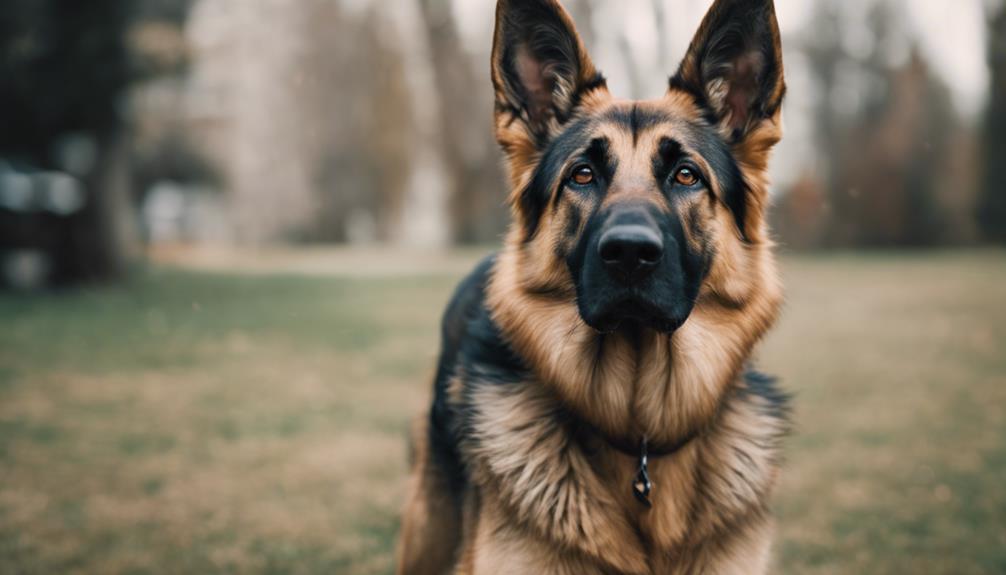
During the adolescent phase, German Shepherd mixes may demonstrate changes in behavior akin to those observed in purebred German Shepherds. This period, typically spanning from 8 to 24 months of age, is marked by various behavioral transformations that are important to understand and address. Here are some key points to consider:
- Increased Independence: German Shepherd mixes may start asserting their independence more during this phase, seeking to explore their surroundings and test boundaries.
- Heightened Vigilance: Adolescence can bring about a more vigilant demeanor in German Shepherd mixes, as they become more alert to their environment and potential threats.
- Protective Instincts: This stage may also see a rise in protective instincts, with your mix displaying more guarding behaviors towards you or your home.
- Training Importance: Consistent training and socialization are crucial during this time to help shape your mix's behavior and ensure they grow into well-adjusted adults.
- Professional Guidance: Seeking guidance from a professional trainer or behaviorist can provide valuable insights and techniques to navigate the adolescent phase successfully.
Managing Independence
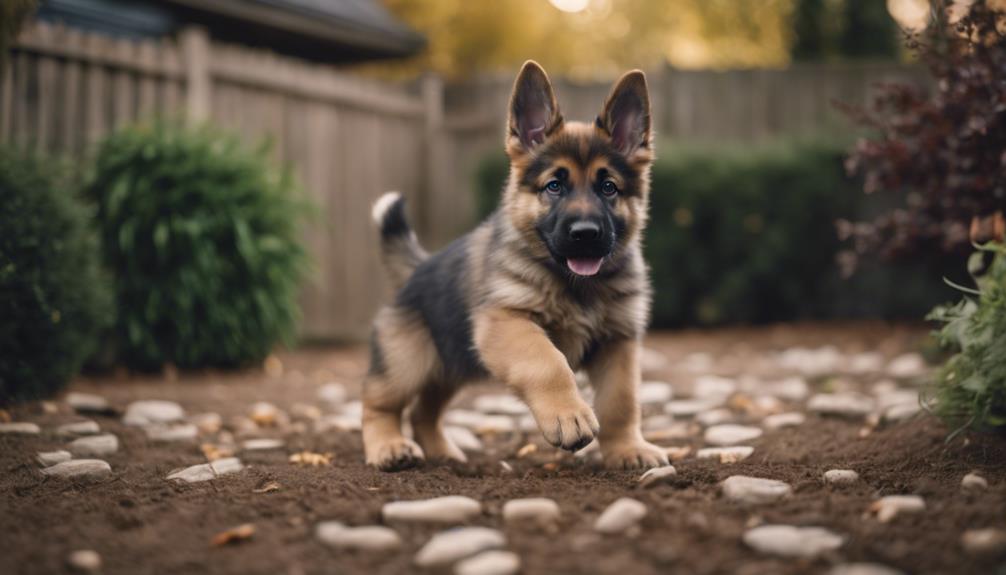
As your adolescent German Shepherd mix explores independence, setting boundaries effectively is key to guiding their behavior. Encouraging responsible decision-making through positive reinforcement can help them understand appropriate actions. Providing structured guidance with consistent training will assist in managing their independence while fostering a positive relationship.
Setting Boundaries Effectively
To effectively manage the independence of adolescent German Shepherd mixes, establish clear and consistent boundaries using positive reinforcement techniques. Setting boundaries is crucial during this adolescent phase to guide their behavior and ensure they grow into well-adjusted adults. Here are some tips to help you navigate this challenging but rewarding time:
- Consistency is Key: Ensure rules are consistently enforced to avoid confusion.
- Positive Reinforcement: Reward good behavior to encourage it to continue.
- Provide Mental Stimulation: Engage their minds with interactive toys and puzzles.
- Physical Exercise: Regular exercise helps channel their energy positively.
- Supervision: Monitor interactions closely to prevent potential conflicts and guide appropriate behavior.
Encouraging Responsible Decision-Making
Encouraging responsible decision-making in adolescent German Shepherd mixes involves guiding their independence through training, consistent reinforcement, and engaging activities. By providing structured guidance, you can help shape their behavior positively. Check out the table below for some practical tips on fostering responsible decision-making in your German Shepherd mix:
| Tips for Encouraging Responsible Decision-Making |
|---|
| 1. Training |
| Ensure consistent training sessions to reinforce desired behaviors. |
| 2. Mental Stimulation |
| Engage your German Shepherd mix in interactive games and puzzles to redirect their energy. |
| 3. Positive Reinforcement |
| Reward good choices and behaviors to encourage responsible decision-making. |
Providing Structured Guidance
During the adolescent phase, managing the independence of German Shepherd mixes involves providing structured guidance through consistent training and clear boundaries. German Shepherd mixes in this phase may challenge authority and seek to assert their independence, making it crucial to establish rules and routines. To help navigate this period effectively, consider the following strategies:
- Implement consistent training sessions to reinforce desired behaviors.
- Offer mental stimulation and engaging activities to channel their energy positively.
- Set clear boundaries to guide their behavior and prevent disobedience.
- Maintain a regular routine to provide stability and predictability.
- Use positive reinforcement techniques and practice patience to support their learning and development.
Handling Moments of Rebellion
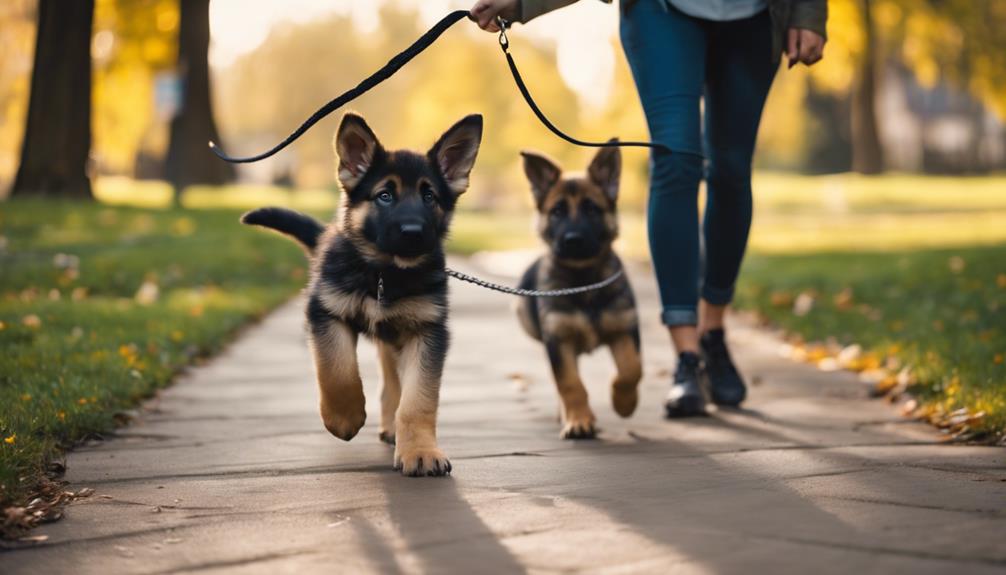
When handling moments of rebellion in adolescent German Shepherd mixes, consistent training, patience, and positive reinforcement are essential. Adolescence, typically between 8 to 24 months, can bring about challenging behaviors like ignoring commands, testing boundaries, and asserting independence. To effectively manage these rebellious tendencies, redirect your dog's attention to desired behaviors and steer clear of confrontational approaches. Remember, your German Shepherd mix is seeking guidance and structure during this phase of development. Below is a table summarizing key strategies for handling moments of rebellion in your adolescent furry companion:
| Strategy | Description | Benefits |
|---|---|---|
| Consistent Training | Regularly reinforce commands and expectations to establish clear communication with your dog. | Builds trust and reinforces good habits |
| Patience | Remain calm and composed when faced with rebellious behaviors, avoiding frustration or anger. | Helps maintain a positive training atmosphere |
| Positive Reinforcement | Reward good behavior promptly to encourage your dog to repeat desirable actions. | Strengthens the bond between you and your pet |
Dealing With Regression

Navigating through moments of regression in your adolescent German Shepherd mix requires consistent reinforcement and positive rewards to address any forgotten commands and maintain obedience levels. During this adolescent phase, it's essential to understand that regression is a common occurrence as your furry friend navigates increased independence and tests boundaries. To effectively deal with regression in your German Shepherd mix, consider the following:
- Consistency is Key: Stick to a regular training schedule to reinforce learned commands.
- Positive Reinforcement: Reward good behavior promptly to encourage obedience.
- Patience and Understanding: Recognize that regression is a normal part of development.
- Seek Professional Help: Consult with a dog trainer or behaviorist for guidance.
- Maintain Boundaries: Clearly establish rules to help your German Shepherd mix understand expectations.
Socialization Challenges
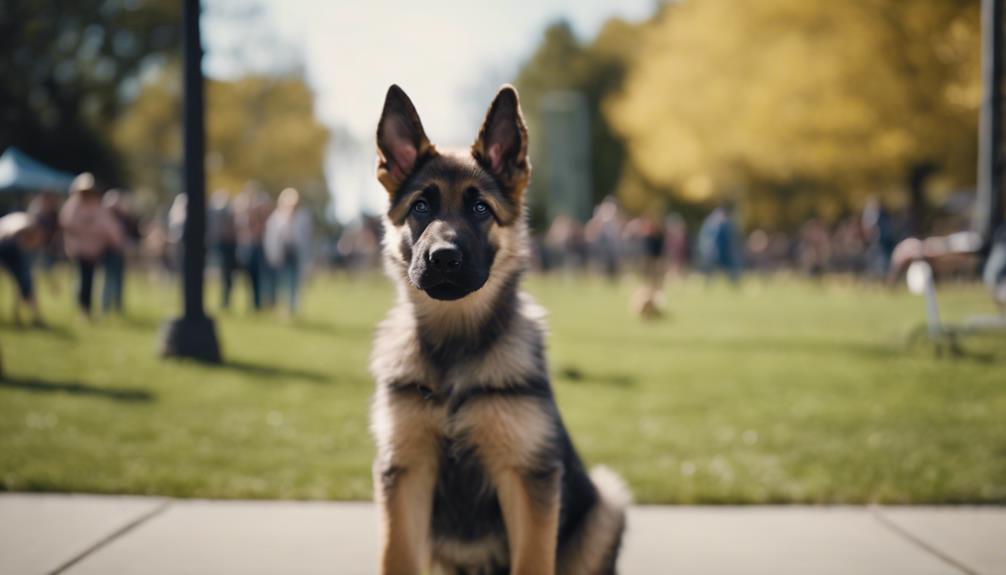
Socialization challenges in adolescent German Shepherd mixes stem from their diverse genetic backgrounds, impacting their interactions with both dogs and humans. The blend of different breeds in German Shepherd mixes can result in unique social behaviors during the adolescent phase. This mix influences how they perceive and engage with other animals and people, requiring tailored approaches to address their specific socialization needs effectively.
During the adolescent phase, German Shepherd mixes may exhibit varying levels of socialization challenges, necessitating patience and understanding. To help these dogs overcome such challenges, it is crucial to provide them with proper exposure to diverse environments, animals, and individuals. This exposure aids in building their confidence and teaching them appropriate social skills.
Training Tips for Adolescents
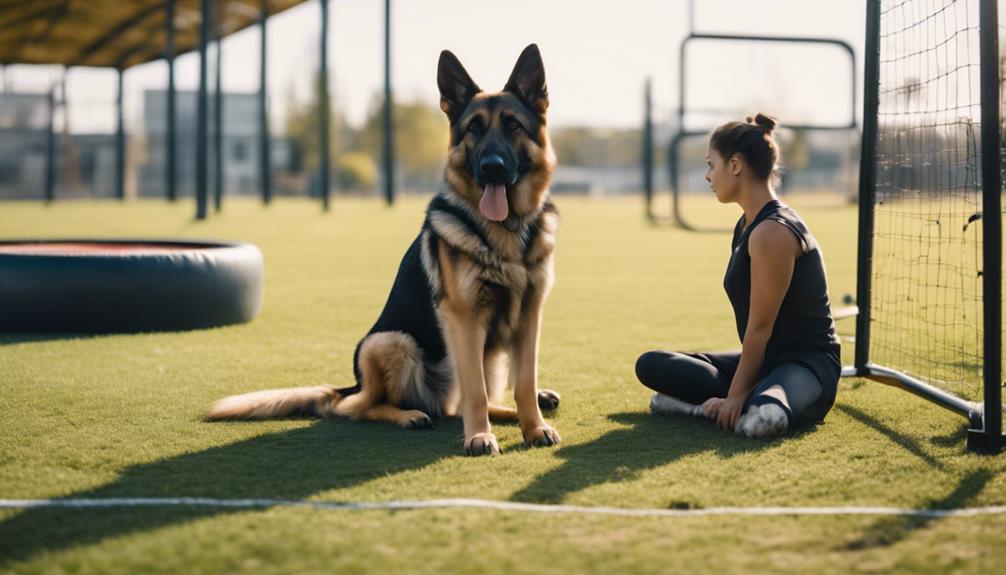
To effectively train adolescent German Shepherd mixes, maintaining consistency in commands and routines is paramount for their development and behavior. These intelligent and energetic dogs require structured training to thrive. Here are some training tips to help you navigate the adolescent phase with your German Shepherd mix:
- Consistency is Key: Stick to a set schedule for training sessions and use the same commands consistently.
- Engage Their Minds: Incorporate mental stimulation through puzzle toys to keep them engaged and prevent boredom.
- Positive Reinforcement: Use treats and praise to reward desired behaviors and encourage learning.
- Structured Walks: Provide daily walks with clear boundaries to help them release energy and stay focused.
- Professional Help: Seek assistance from professional trainers for specialized training needs or behavior challenges.
Health Concerns in Adolescents
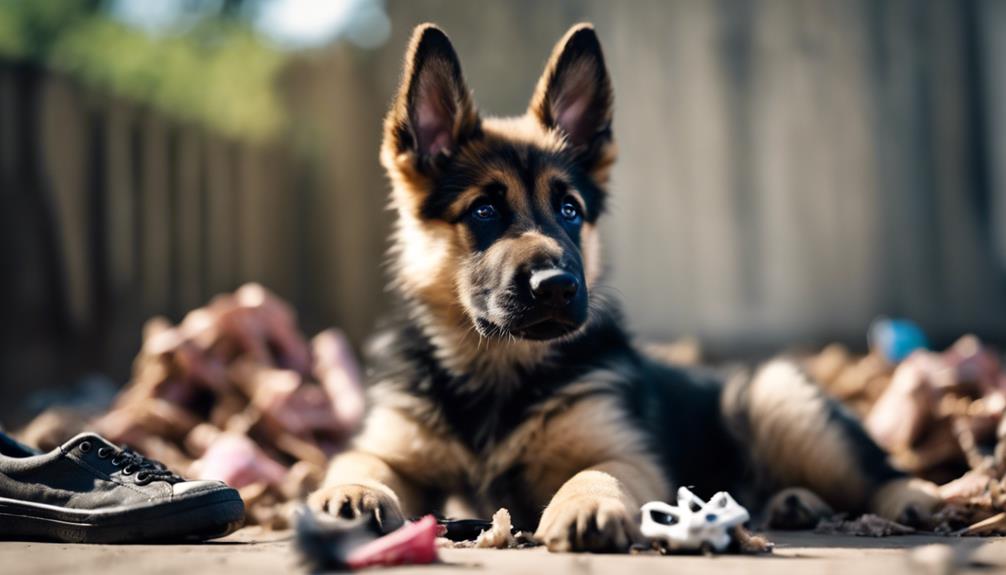
As your adolescent German Shepherd mix goes through growth spurts, it's essential to be aware of potential impacts on their health. Managing hormonal changes during this stage can help address behavioral challenges that may arise. Taking proactive steps to monitor and maintain your dog's health can ensure a smooth transition through adolescence.
Growth Spurts Impact
During adolescence, growth spurts in German Shepherd mixes can significantly impact their health, necessitating careful monitoring and proactive care. These rapid changes in size and weight can affect their overall well-being. To address this, consider the following:
- Monitor bone and joint development closely to prevent issues like hip dysplasia.
- Ensure proper nutrition and controlled exercise to support healthy growth.
- Regular vet check-ups are essential to identify any health concerns early on.
- Familiarize yourself with breed-specific health risks such as elbow dysplasia and bloat.
- Understand that proactive measures can help address potential health issues during growth spurts in adolescent German Shepherd mixes.
Hormonal Changes Management
Hormonal changes in adolescent German Shepherd mixes often manifest in behavior shifts such as increased independence and territorial tendencies. These changes can be managed through consistent training, socialization, and positive reinforcement. Health concerns during this phase may include the onset of reproductive maturity, impacting behavior and interactions with other dogs. To address emerging behavioral issues, it is essential to understand the impact of hormonal changes on health and behavior. Adolescents may display signs of maturity like marking territory, which can be controlled with appropriate training and outlets for natural behaviors. Successfully navigating the adolescent phase in German Shepherd mixes involves recognizing and proactively managing hormonal changes to promote a healthy transition into adulthood.
Behavioral Challenges Addressing
Addressing the health concerns in adolescent German Shepherd mixes involves recognizing the potential behavioral challenges that may arise due to breed-specific health issues.
- Regular vet check-ups and preventive care can help manage these health issues in adolescent German Shepherd mixes.
- Early detection and intervention for health concerns can improve the quality of life for adolescent German Shepherd mixes.
- Proper nutrition, exercise, and weight management are crucial for preventing and managing health challenges in adolescent German Shepherd mixes.
- Understanding the breed-specific health risks and symptoms can aid in proactive health management during the adolescent phase.
- Adolescents may exhibit health concerns like hip dysplasia, elbow dysplasia, and degenerative myelopathy, common in German Shepherds.
Taking proactive steps can significantly impact the well-being and longevity of your adolescent German Shepherd mix.
Exercise Needs in Adolescents
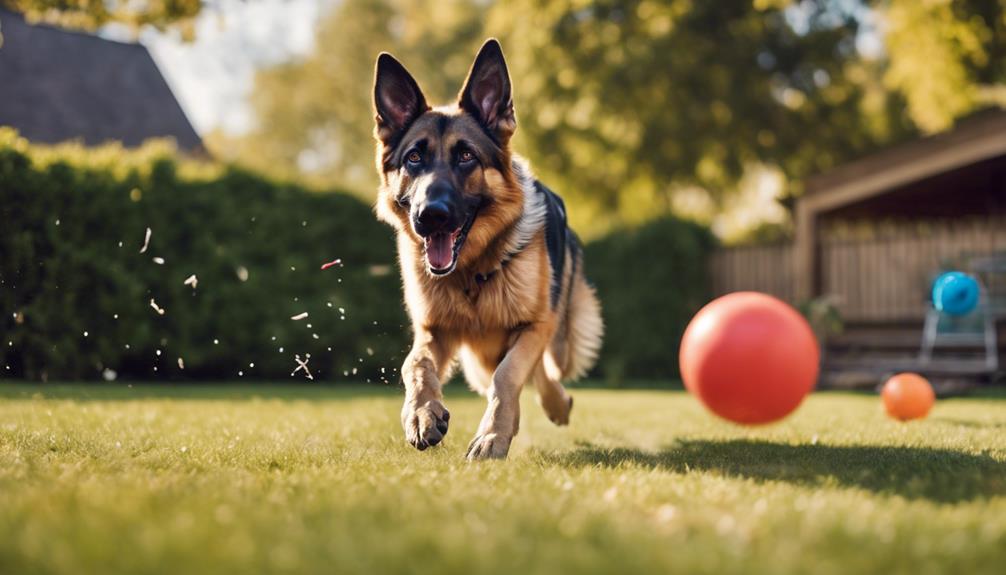
To ensure the well-being of adolescent German Shepherd mixes, it is crucial to tailor their exercise routines to match their energy levels and preferences. Regular exercise is vital for these young dogs to expend their energy, prevent boredom, and promote overall health. Incorporating a variety of physical activities such as walks, runs, and play sessions is essential to provide them with the necessary stimulation. By customizing the exercise regimen to suit the specific mix's needs, you can ensure that they are adequately engaged and fulfilled.
Interactive games and training sessions during exercise not only help in physical conditioning but also strengthen the bond between you and your adolescent German Shepherd mix. Moreover, adequate exercise plays a significant role in managing behavioral issues that may arise during this developmental stage. By meeting their exercise needs, you are not only enhancing their physical fitness but also supporting their mental well-being. Stay attuned to your mix's preferences and energy levels to ensure a fulfilling and healthy exercise routine during this crucial adolescent phase.
Nutrition for Adolescent Mixes

When considering the well-being of your adolescent German Shepherd mix, it is imperative to provide a balanced diet rich in protein, vitamins, and minerals to support their growth and development. Consult with a veterinarian to determine the appropriate feeding schedule and portion sizes based on the mix's size, activity level, and health needs. Consider transitioning to an adult dog food formula designed for large breeds as the mix reaches maturity to support joint health and weight management. Monitor the mix's weight and body condition regularly to adjust their diet accordingly and prevent obesity or nutritional deficiencies. Incorporate high-quality treats and occasional supplements like fish oil for added nutrients and to encourage good behavior during training sessions.
- Consult with a veterinarian for tailored feeding recommendations.
- Transition to adult dog food for joint health and weight management.
- Regularly monitor weight and body condition for adjustments.
- Use high-quality treats and supplements to support training sessions.
- Prioritize a diet rich in protein, vitamins, and minerals for growth and development.
Grooming Adolescents

To maintain your adolescent German Shepherd mix's coat health, brushing several times a week is essential to reduce shedding and prevent matting. Bathing should be done only when necessary, typically every 2-3 months, to preserve the natural oils in their skin. Remember to trim their nails every 4-6 weeks and check their ears weekly to prevent discomfort and infections during this active phase.
Brushing for Shedding
Regularly brushing your adolescent German Shepherd mix is essential for managing shedding, especially during this phase when fur can be heavy. To effectively handle shedding in your furry companion, consider the following tips:
- Use a slicker brush or grooming glove to remove loose fur and prevent matting in your dog's coat.
- Focus on areas like the undercoat and hindquarters where shedding is more pronounced.
- Implement a consistent grooming routine to keep your dog's coat healthy and reduce shedding around your home.
- Engage in regular grooming sessions to bond with your German Shepherd mix adolescent and maintain their overall well-being.
Bathing Frequency
Maintaining proper bathing frequency is crucial for grooming your adolescent German Shepherd mix, ensuring their hygiene and coat health are well-managed. German Shepherd mixes in the adolescent phase typically require bathing every 6-8 weeks to control shedding and promote a clean, healthy coat. Factors such as the dog's activity level and coat type may influence bathing frequency. It is essential to use dog-specific shampoos to prevent skin irritation and preserve the coat's natural oils. For personalized grooming recommendations tailored to your dog's individual needs, consider consulting with a groomer or veterinarian. Below is a table summarizing the key points for bathing your adolescent German Shepherd mix:
| Aspect | Bathing Frequency | Recommended Shampoo |
|---|---|---|
| Frequency | Every 6-8 weeks | Dog-specific |
| Benefits | Controls shedding | Maintains coat health |
| Considerations | Activity level | Coat type |
Mental Stimulation Needs

For optimal mental health and behavior, providing mental stimulation is crucial for adolescent German Shepherd mixes. These intelligent and active dogs require mental challenges to prevent boredom and behavioral issues. Here are five ways to meet the mental stimulation needs of your German Shepherd mix:
- Interactive Toys: Engage your dog's mind with toys that dispense treats or require problem-solving to access.
- Puzzle Games: Provide puzzle toys that encourage your dog to think and strategize to receive a reward.
- Training Exercises: Regular training sessions not only reinforce good behavior but also stimulate your dog's mental faculties.
- Scent Work: Introduce scent work activities to tap into your dog's strong sense of smell and provide mental enrichment.
- Agility Training: Agility courses offer physical exercise along with mental challenges, keeping your German Shepherd mix mentally sharp.
Setting Boundaries Effectively

When setting boundaries for your adolescent German Shepherd mix, clarity and consistency are key. Clearly define and communicate rules to your dog to establish expectations and reinforce desired behaviors. Consistent enforcement of boundaries, coupled with positive reinforcement techniques, can help guide your dog towards respecting limits effectively.
Clear Rules Communication
To effectively communicate boundaries to your adolescent German Shepherd mix, ensure you establish clear and consistent rules. Setting clear rules is essential for your dog's understanding and behavior. Here are some tips to help you communicate effectively:
- Use positive reinforcement techniques to encourage desired behaviors.
- Set clear expectations for your German Shepherd mix to follow.
- Implement boundaries early on to avoid confusion.
- Be consistent in enforcing rules to help your dog understand expectations.
- Establishing boundaries will help your German Shepherd mix feel secure and know what is expected during this crucial developmental phase.
Consistent Enforcement Approach
Consistently enforcing boundaries with your adolescent German Shepherd mix is key to fostering positive behaviors and a structured environment for their development. Setting clear rules and boundaries is essential for shaping desired behaviors and preventing unwanted actions. This consistent enforcement approach helps your dog understand expectations, reinforcing leadership and promoting a harmonious relationship. Here is a table summarizing the benefits of a consistent enforcement approach:
| Benefits of Consistent Enforcement |
|---|
| Shapes desired behaviors |
| Prevents unwanted actions |
| Reinforces leadership |
Adolescent Mixes and Other Pets

Introducing your adolescent German Shepherd mix to other pets requires a gradual and supervised approach to prevent conflicts and promote harmonious interactions. Adolescence can be a challenging time for German Shepherd mixes and other pets due to potential dominance issues or territorial behaviors. To help navigate this phase successfully, consider the following tips:
- Slow Introduction: Start by allowing brief and controlled interactions between your German Shepherd mix and other pets.
- Supervised Encounters: Always supervise interactions to intervene in case of any signs of aggression or discomfort.
- Positive Reinforcement: Use treats and praise to reward good behavior when your German Shepherd mix interacts positively with other pets.
- Individual Personalities: Understand the unique personalities and needs of each pet to facilitate a harmonious relationship.
- Professional Guidance: Consult with a professional trainer or behaviorist if you encounter persistent issues or need additional support.
Seeking Professional Help

For effective assistance with managing behavioral challenges in your adolescent German Shepherd mix, consider consulting professional trainers, behaviorists, and veterinarians. During the adolescent phase, your German Shepherd mix may exhibit rebellious and challenging behaviors that require expert guidance. Seeking professional help can provide you with tailored training plans and personalized strategies to address your dog's specific needs. Professionals trained in force-free methods can offer valuable support in navigating this crucial developmental stage.
Trainers can help you establish positive training techniques to reinforce good behavior and discourage unwanted actions. Behaviorists specialize in understanding and modifying behaviors, offering insights into why your dog may be acting out during adolescence. Veterinarians can also play a role in addressing behavioral issues by ruling out any underlying medical causes that could be contributing to your dog's behavior.
Frequently Asked Questions
How Long Does Adolescence Last in German Shepherds?
Adolescence in German Shepherds typically lasts from 8 to 24 months, a crucial time of development marked by physical and behavioral changes. Hormonal shifts and brain maturation contribute to the challenges faced. Consistent training, socialization, and patience are essential.
Do German Shepherds Go Through a Rebellious Phase?
Yes, German Shepherds do go through a rebellious phase during adolescence. They may exhibit stubbornness, selective hearing, and challenging behaviors. Behavior training, patience, and consistent guidance are crucial for helping them navigate this phase successfully.
What Age Do German Shepherds Go Through Puberty?
You should be aware that German Shepherds typically go through puberty between 6 to 12 months of age. Signs of puberty include increased energy, mounting behavior, and potential aggression. Proper training and socialization are essential during this time.
What Is the Juvenile Stage of a German Shepherd?
In the juvenile stage, your German Shepherd transitions from a newborn to a more active and exploratory pup. This phase includes opening eyes, hearing, and starting to walk and play. Socialization and early training are crucial for a well-rounded adult dog.
Conclusion
In conclusion, navigating the adolescent phase in German Shepherd mixes can be a challenging yet rewarding journey. By understanding their behavioral changes, managing their independence, and seeking professional help when needed, you can guide your furry companion through this developmental period with patience and success. Remember, consistency in training and socialization, along with setting boundaries effectively, are key in helping your German Shepherd mix become a well-adjusted and well-behaved adult dog. Stay patient and positive on this journey of growth and development.
